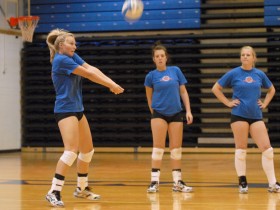
The Sport Specific Approach to Strength Training Programs
Unfortunately, most strength training programs fall well short of what an athlete requires…
Bodybuilding and Olympic weightlifting programs still dominate many athletes’ training regimes. While these types of training have their place, strength training for sport consists of a more refined approach than simply lifting heavy weights as many times as possible.
This article outlines the concept and the benefits of a periodized strength training plan. This is the most effective approach to strength training for sport. Not only does it help in the prevention of over training, it gives the athlete the best chance of peaking physically at the right time.
Exercise Selection
The principle of specificity states that training should mirror the demands of the sport as closely as possible (1). This applies not only to way the body’s energy systems and neuromuscular system is taxed (through manipulation of intensity and rest intervals etc) but also to the movement patterns of each exercise.
Bodybuilders tend to isolate a muscle group and work it to exhaustion. Athletes on the other hand should train movements rather than muscles. A simple example is the vertical jump. The muscles involved in this action (calves, quadriceps, hamstrings, gluteals etc.) could be trained separately with exercise choices such as toe raises, leg extensions, leg curls, kickbacks and so on. A more appropriate exercise however is a barbell squat, which closely matches the movement pattern of the vertical jump. Taken a step further, jump squats are even more specific to jumping and it’s not surprising that they increase vertical jump performance to the greatest extent (4).
A sport-specific exercise for basketball and volleyball Athletes must divide their time and energy amongst various types of training – endurance, strength and power, speed and agility, tactical etc., and find the time to recover! By choosing only the most appropriate resistance exercises volume can be kept to a minimum saving energy for other types of training.
This has led many coaches to incorporate Olympic weight lifting into their strength training programs, almost without question. The rationale is that just a few Olympic lifts will build all-round strength and power. Whilst exercise such as power cleans can be beneficial to some athletes, for many there are more specific and more appropriate options (2).
Many of the sample strength training programs within this section of the website consist of relatively few exercises. This is deliberate and while it may seem unbalanced at first glance, it takes into account other training the athlete is expected to complete.
Different Types of Strength Training
Unlike bodybuilding, where the only aim is to increase the size and appearance of muscles, strength training programs for sport ultimately must develop either explosive power or muscular endurance (2). However, rather than immediately embarking on a program to improve either or both of these fitness components, a more effective approach is to first build a solid foundation…
Basic Strength
Basic strength training programs adapt the body for more strenuous resistance training later on. It’s objective is to prepare the body by targeting all of the major muscle groups, tendons, ligaments and joints helping to prevent injury (2).
The less experienced an athlete is, the more time they will need to spend developing foundational strength before progressing onto more advanced forms of resistance training. But even experienced athletes should set aside some time during the year to complete a phase of basic strength training. It can help to redress some of the muscle imbalances that inherently occur with competitive sport.
Hypertrophy
Some athletes will benefit from increasing their lean body mass by adding extra muscle bulk. However, the number of athletes that require hypertrophy training or a phase of bodybuilding is far fewer than most would expect. Larger muscles are not necessarily stronger and more weight – even lean, active weight – can be a hindrance in many sports.
Maximal Strength
Bodybuilders have exceptional muscle mass but they are typically bigger than they are strong. Maximal strength training programs do not necessarily increase the size of a muscle (hypertrophy) but they do lead to neuromuscular adaptations that are favourable to most athletes. Even endurance athletes can benefit from maximal strength training (5,6).
Explosive Power
Just as an athlete can be extremely muscular and lack an associated level of strength, they can also be exceptionally strong but lack significant power. Most athletic movements occur much more rapidly and demand significantly more power than lifting maximal loads. If maximal strength is not converted into sport-specific power, athletic performance will not improve – certainly not to the extent that it could.
Muscular Endurance
While many sports are dominated by powerful, explosive actions some athletes are required to overcome a relatively low resistance but for a prolonged period of time. Just as power athletes should convert maximal strength into explosive power, endurance athletes should aim to convert maximal strength into muscular endurance.
Of course, many team sports require a combination of the two – power and strength endurance – and developing both simultaneously without one negating the other requires careful consideration.